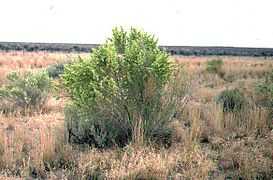Atriplex canescens
| Atriplex canescens | |
|---|---|
 | |
| Scientific classification | |
| Kingdom: | Plantae |
| (unranked): | Angiosperms |
| (unranked): | Eudicots |
| (unranked): | Core eudicots |
| Order: | Caryophyllales |
| Family: | Amaranthaceae |
| Genus: | Atriplex |
| Species: | A. canescens |
| Binomial name | |
| Atriplex canescens (Pursh) Nutt. | |
Atriplex canescens, Chamiso, Chamiza, Four wing saltbush, Four-wing saltbush, and Fourwing saltbush, is a species of evergreen shrub in the Amaranthaceae family, which is native to the western and mid-western United States.
Description
Atriplex canescens has a highly variable form, and readily hybridizes with several other species in the Atriplex genus. The degree of polyploidy also results in variations in form. Its height can vary from 1 foot to 10 feet, but 2 to 4 feet is most common. The leaves are thin and 0.5 to 2 inches long.
It is most readily identified by its fruits, which have four wings at roughly 90 degree angles and are densely packed on long stems.

Habitat
Fourwing saltbush is most common in early succession areas such as disturbed sites and active sand dunes. It is also found in more mature successions dominated by sagebrush—Artemisia tridentata and shadscale.
Uses
Among the Zuni people, an infusion of dried root and blossoms[1] or a poultice of blossoms is used for ant bites.[2] Twigs are also attached to prayer plumes and sacrificed to the cottontail rabbit to ensure good hunting.[3]
References
External links
| Wikimedia Commons has media related to Atriplex canescens. |
- USDA Forest Service: Atriplex canescens
- USDA Plants Profile: Atriplex canescens
- UC/Jepson Manual treatment - Atriplex canescens